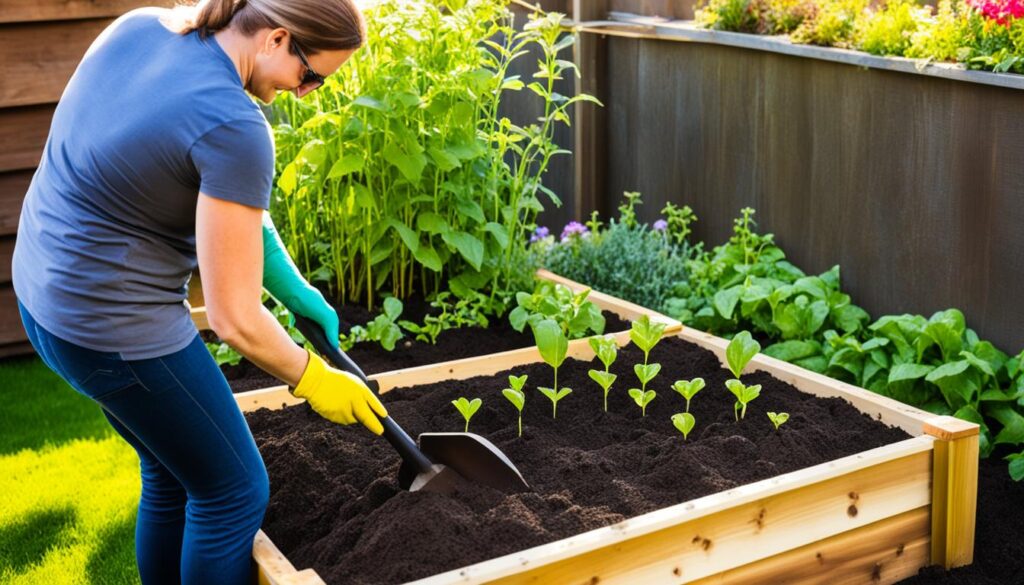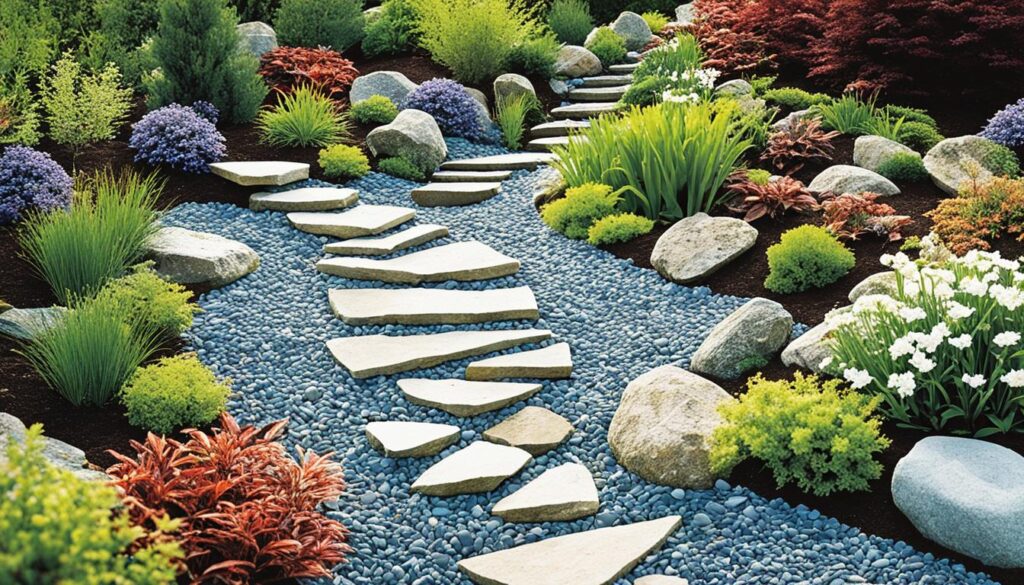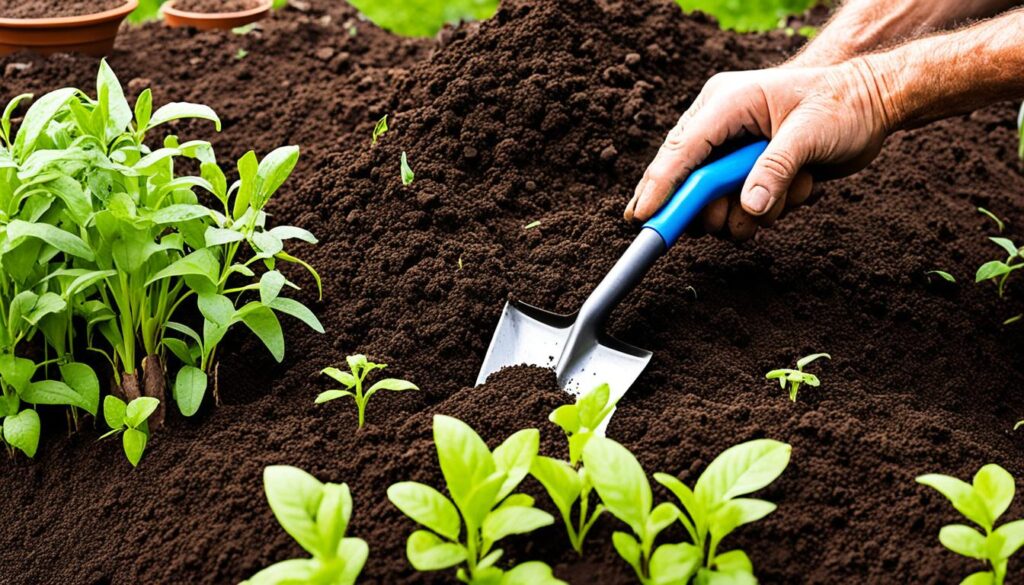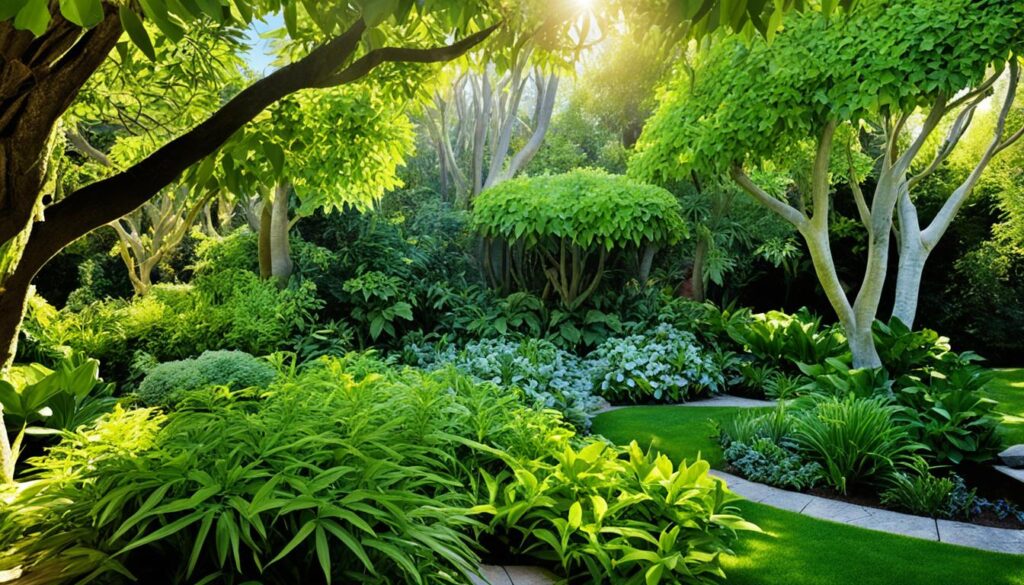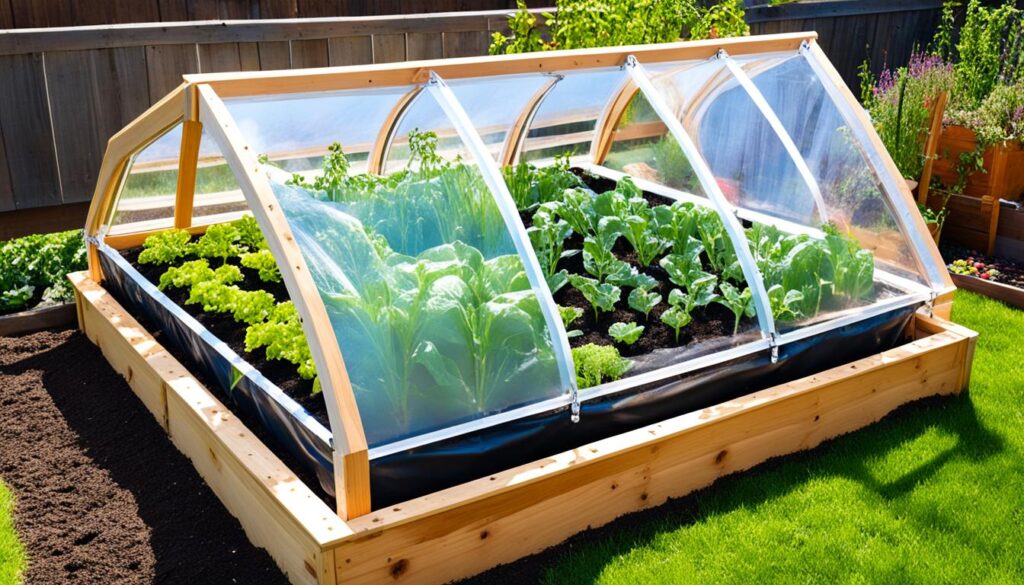In this article, I will explore the possibility of growing herbs in less sunlit spots. Discover which shade-tolerant herbs can flourish in your garden, and learn valuable tips for successfully growing herbs in the shade.
- Shade-tolerant herbs can thrive in areas with less sunlight.
- Understanding different levels of shade and their impact on herb growth is essential.
- Choose herbs that are known for their ability to thrive in low light conditions.
- Provide adequate soil and watering conditions for shade-loving herbs.
- Create a favorable microclimate for optimal growth in the shade.
Understanding Shade in Herb Gardening
Before delving into specific herbs that can thrive in shade, it’s essential to understand the different levels of shade in your garden and how it can impact herb growth. Shade-loving herbs, also known as shade garden herbs, have unique characteristics that make them well-suited for low-light conditions.
When it comes to shade, there are several factors to consider. The first is the intensity of the shade, which can range from partial shade to full shade. Partial shade refers to areas that receive filtered sunlight for a few hours a day, while full shade means the area is predominantly shaded throughout the day.
Another important factor is the duration of shade. Some areas may experience shade only during certain times of the day, while others may be constantly shaded due to nearby trees or buildings. Understanding these variations in shade levels will help you select the right herbs for your specific garden conditions.
Shade-loving herbs are specially adapted to lower light levels and have evolved to thrive in such environments. These herbs often have larger and broader leaves compared to their sun-loving counterparts, allowing them to effectively capture and utilize available light.
In addition to their unique leaf structures, shade garden herbs often have a slower growth rate and lower water requirements, making them well-suited for shady areas where moisture may be limited. Some shade-loving herbs include mint, parsley, lemon balm, and chervil, among others.
Shade-loving herbs not only add visual interest to your garden but also offer a range of culinary and medicinal benefits. They can be used in cooking, teas, infusions, and even homemade skincare products.
In the next section, we will explore some of the best shade garden herbs you can grow in your garden and learn how to care for them to ensure their optimal growth and flavor.
Selecting the Right Herbs for Shade
When it comes to creating a thriving shade herb garden, selecting the right herbs is key. Not all herbs are equally suited to low light conditions, but there are several shade-tolerant herbs that can flourish beautifully even without abundant sunlight. In this section, I’ll introduce you to a selection of these shade-loving herbs that will thrive in your shady garden.
Mint
One of the best herbs for low light conditions is mint. Whether it’s spearmint, peppermint, or lemon balm, these aromatic herbs can thrive with minimal sunlight. Mint is known for its vigorous growth habit, making it a great choice for filling in shady areas of your garden. Use fresh mint leaves to add a refreshing twist to your drinks, salads, and desserts.
Parsley
Parsley is another herb that tolerates shade exceptionally well. With its vibrant green leaves and delicate flavor, parsley adds a splash of freshness to any dish. This versatile herb pairs wonderfully with both savory and sweet flavors, making it a must-have for any shade garden.
Coriander
Also known as cilantro, coriander is a herb that can thrive in partial shade. It offers a unique and refreshing taste that enhances many cuisines, including Mexican, Indian, and Thai. The leaves and seeds of coriander are widely used in various dishes to add a burst of flavor.
Chives
Chives are a lovely addition to any herb garden, particularly in shady areas. These slender, hollow leaves boast a delightful onion-like flavor that pairs well with a variety of dishes. Snip some fresh chives to sprinkle over soups, salads, or baked potatoes.
Lemon Verbena
If you’re looking to add a citrusy twist to your herb garden, lemon verbena is an excellent choice. This aromatic herb thrives in both partial shade and full sun. The leaves exude a lovely lemon fragrance, making them perfect for infusing teas, flavoring desserts, or adding a zesty touch to your dishes.

These are just a few examples of shade-tolerant herbs that you can grow in your shade garden. From mint to parsley, chives to coriander, and lemon verbena, there are plenty of options to choose from. Experiment with different herbs and create a thriving shade herb garden that adds beauty, fragrance, and flavor to your outdoor space.
Providing Adequate Soil and Watering Conditions
While growing herbs in shady areas is possible, it is important to note that these shade-loving herbs still require the right soil and watering conditions to thrive. Here are some valuable tips to help you create the ideal environment for your shade garden herbs.
Preparing the Soil
Start by preparing the soil in the shaded area where you plan to grow your herbs. Growing Herbs in Shady Areas requires soil that is rich in organic matter and well-draining. Add compost or organic matter to improve the soil’s fertility and structure. This will ensure that your shade-loving herbs have access to nutrients and sufficient drainage.
Optimizing Drainage
In areas with limited sunlight, excess moisture can become a problem. To optimize drainage, consider adding a layer of gravel or small rocks at the bottom of your herb planting area. This will help prevent water from pooling around the roots and potentially causing root rot. Additionally, avoid overwatering your herbs as excessive moisture can be detrimental to their growth. Tips for Growing Herbs in the Shade include monitoring the moisture levels and allowing the soil to dry out slightly between waterings.
Maintaining Adequate Moisture Levels
While it’s important to avoid overwatering, shade garden herbs still need a consistent moisture supply. Regularly check the moisture levels in the soil and water your herbs as needed. Tips for Growing Herbs in the Shade include providing deep and thorough watering sessions to ensure the water reaches the deeper roots. Applying a layer of organic mulch around your herbs can help retain moisture in the soil and reduce evaporation.
By following these tips and providing your shade-loving herbs with the right soil and watering conditions, you can ensure their successful growth and development. Keep in mind that different herbs may have specific soil and watering requirements, so it is always a good idea to refer to individual plant care guidelines for optimal results.
Creating the Ideal Microclimate for Shade Herbs
When it comes to growing herbs in shady areas, creating the ideal microclimate is key to their success. While shade-tolerant herbs are adaptable, providing them with optimal growing conditions will enhance their health and productivity. In this section, I’ll share some valuable tips and techniques for creating a favorable environment for your shade-loving herbs.
1. Strategic Positioning
Properly positioning your shade herbs is crucial. While they thrive in low light conditions, it’s important to find the right balance between shade and access to some sunlight. Place your pots or plant beds where they receive a few hours of indirect sunlight each day. This will provide the necessary light energy for photosynthesis and ensure healthy growth.
2. Mulching
Mulching plays a vital role in maintaining moisture levels and temperature control in your shade herb garden. Apply a layer of organic mulch, such as straw or shredded bark, around your plants. This will help retain moisture in the soil, prevent weed growth, and regulate the temperature, creating a favorable microclimate for your herbs to thrive.
3. Companion Planting
Companion planting involves growing different plants together that have mutually beneficial relationships. In a shade herb garden, companion planting can provide multiple benefits. For example, planting shade-loving herbs such as cilantro or parsley alongside taller plants like tomatoes can provide shade and help retain moisture. Additionally, some companion plants, like marigolds, can repel pests that may pose a threat to your shade herbs.

4. Adequate Watering
While shade herbs generally require less water than those grown in full sun, it’s important not to let them dry out. Monitor the moisture levels in the soil and water when needed. Ensure that your herbs receive consistent but moderate watering to avoid overwatering or waterlogged soil, which can lead to root rot or other issues.
5. Pruning and Thinning
Regular pruning and thinning of your shade herbs can help improve airflow and prevent overcrowding. This allows for better light penetration and reduces the risk of disease or fungal issues. Remove any dead or yellowing leaves and trim back excessive growth to maintain healthy plants.
By implementing these techniques, you can create the ideal microclimate for your shade herbs, ensuring they receive the right amount of light, moisture, and airflow. Remember to observe your herbs closely and make any necessary adjustments to optimize their growing conditions.
Harvesting and Using Shade Herbs
Just because your herbs are in the shade doesn’t mean you can’t enjoy their wonderful flavors and aromas. In this section, I’ll provide guidance on when and how to harvest your shade-loving herbs, as well as creative ideas for incorporating them into your culinary endeavors.
Harvesting Shade Garden Herbs
Harvesting shade herbs is a gratifying experience, as it allows you to savor the fruits of your labor. The optimal time to harvest depends on the specific herb, but a general rule of thumb is to pick leaves and stems in the morning when the essential oils are at their peak. This ensures the best aroma and flavor in your culinary creations.
When harvesting shade garden herbs, use a sharp pair of garden shears or scissors to cut just above a set of healthy leaves. This encourages new growth and maintains the plant’s shape. Remove any damaged or discolored leaves to enhance the overall quality of your harvest.
Creative Uses for Shade Herbs
Once you’ve harvested your shade herbs, the possibilities for incorporating them into your cooking are endless. Here are some creative ideas to inspire you:
- Add fresh basil leaves to your homemade pizzas or pasta dishes for a burst of aromatic flavor.
- Create a refreshing herbal tea by steeping a combination of mint and lemon balm leaves.
- Add finely chopped chives to your omelettes or scrambled eggs for a touch of mild onion flavor.
- Garnish your salads with freshly picked parsley or cilantro leaves to add a vibrant burst of freshness.
Feel free to experiment and explore new flavor combinations to make the most of your shade garden herbs. Remember to always taste and adjust the seasoning to achieve the perfect balance of flavors.
In the next section, we will address common challenges faced when growing herbs in the shade and provide practical solutions to overcome them.
Common Challenges and Solutions for Shade Herb Gardening
Growing herbs in shady areas can present unique challenges for gardeners. However, with the right knowledge and solutions, you can overcome these obstacles and successfully cultivate a thriving shade herb garden. In this section, I’ll address some of the common issues faced by gardeners when growing herbs in the shade and provide practical tips to help you overcome them.
Pest Control
One of the challenges of shade herb gardening is dealing with pests. Growing Herbs in Shady Areas can attract a variety of pests, including slugs, snails, and aphids. These pests can damage the leaves and inhibit the growth of your herbs.
To combat pests, it’s important to regularly inspect your plants for signs of infestation. Remove any visible pests by hand, and consider using natural pest control methods such as companion planting or organic insecticides. Additionally, keeping your garden clean and free of debris can help reduce the likelihood of pest infestations.
Maintaining Optimal Light Levels
In shady areas, herbs may not receive the same amount of sunlight as they would in sunnier spots. Tips for Growing Herbs in the Shade require a minimum of 4-6 hours of indirect sunlight each day to thrive.
To maintain optimal light levels for your shade herb garden, choose herbs that are known for their shade tolerance. Some examples include mint, parsley, and chives. These herbs can adapt to lower light conditions and still provide a bountiful harvest.
Another solution is to strategically place reflective surfaces such as mirrors or white stones near your herbs. This can help redirect and amplify the available sunlight, providing your shade-loving herbs with the light they need to grow.
Proper Watering Techniques
Watering herbs in shady areas requires some adjustments compared to sunlit gardens. Tips for Growing Herbs in the Shade involve ensuring that the soil doesn’t become waterlogged, as excessive moisture can lead to root rot.
Water your herbs in the morning to allow the leaves to dry before nightfall, reducing the risk of fungal diseases. Monitor the moisture levels in the soil and water only when necessary, taking care not to overwater.
Applying a layer of organic mulch around your herbs can help retain moisture and regulate soil temperature. This will further support the growth and health of your shade herb garden.
By addressing these common challenges and implementing the suggested solutions, you can create an environment in which your shade herbs can thrive. With a little patience and care, you’ll soon enjoy a bountiful harvest of herbs from your shade garden.

Designing a Beautiful Shade Herb Garden
Who says a shade garden can’t be visually appealing? When it comes to creating a stunning and functional herb garden in shady areas, the possibilities are endless. In this section, I’ll share design ideas and tips to help you transform your shaded space into a captivating landscape filled with beautiful shade garden herbs.
One key aspect to consider is the combination of different herbs, colors, and textures. By selecting a variety of shade-tolerant herbs, you can create a visually striking garden that will delight your senses. Imagine the vibrant shades of purple basil, the delicate foliage of lemon balm, and the elegant flowers of chives, all coming together to form a harmonious and eye-catching display.
To add depth and dimension to your shade herb garden, consider incorporating various levels and heights. Place taller herbs, such as rosemary or sage, at the back to create a backdrop for the smaller, trailing herbs, like thyme or creeping Jenny, which can spill over the edges of containers or garden beds. This layering effect will not only enhance the visual appeal but also maximize the use of space.
Another element to consider is the use of containers. This allows you to create portable herb arrangements that can be placed strategically around your garden or patio. Choose ornamental containers in different shapes, sizes, and materials to add a touch of personality to your shade herb garden. Don’t forget to select containers that provide proper drainage to ensure the health and vitality of your herbs.
In addition to the design aspects, it’s crucial to consider the practicality of your shade herb garden. Position your herb beds or containers in locations that receive the optimal amount of shade throughout the day. While herbs may tolerate shade, they still require some sunlight to thrive. Aim for at least 4-6 hours of dappled or filtered sunlight to ensure healthy growth.
Finally, don’t forget to include pathways and seating areas in your shade herb garden design. This will not only make it easier to access and tend to your herbs but also provide a tranquil space where you can relax and enjoy the beauty and aromas of your garden.
By following these design ideas and tips, you can create a beautiful shade herb garden that not only enhances the visual appeal of your outdoor space but also provides an abundance of shade garden herbs for culinary and medicinal purposes. Get creative, experiment with different combinations, and let your imagination flourish as you bring your shade herb garden to life.
Tips for Overwintering Shade Herbs
As the colder months approach, it’s important to take special care of your shade-tolerant herbs to ensure their survival through the winter. By following a few expert pieces of advice, you can prepare your shade herb garden for the cold season, protect your herbs from frost, and ensure they thrive once the growing season returns.
Preparing Your Shade Herb Garden for Winter
Before the first frost hits, it’s crucial to prepare your shade herb garden for winter. Start by tidying up the garden, removing any dead foliage or weeds that may have accumulated throughout the growing season. This cleanup will prevent pest infestations and diseases from affecting your herbs during winter.
Next, give your shade-tolerant herbs a nutrient boost. Apply a layer of organic compost or well-rotted manure to enrich the soil and provide essential nutrients. This will give your herbs the strength they need to endure the colder months.
Protecting Your Herbs from Frost
Frost can be detrimental to herbs, especially those growing in shade. To protect your herbs from frost, consider the following measures:
- Cover your shade herb garden with a frost blanket or horticultural fleece. This protective barrier will insulate your herbs and prevent the freezing temperatures from damaging them.
- Move potted shade herbs indoors or into a greenhouse. This will provide them with the warmth and protection they need during the winter.
- Group your herbs together. Combining them in one area can create a microclimate that retains more heat and reduces the risk of frost damage.
By implementing these protective measures, you can give your shade-tolerant herbs the best chance of survival during frosty winter days.
Ensuring Thriving Growth in the Next Growing Season
Once the winter frost has passed and the growing season returns, it’s time to ensure your shade herbs thrive once again. Follow these tips to promote healthy growth:
- Remove any frost protection covers and gently prune back any dead or damaged foliage to encourage new growth.
- Check the soil moisture and provide adequate watering. Despite being shade-tolerant, herbs still need sufficient moisture to thrive.
- Monitor for pests and diseases. Inspect your shade herb garden regularly and take immediate action if you notice any signs of infestation or disease.
By following these overwintering tips, you can enjoy vibrant and flourishing shade-tolerant herbs year after year, bringing beauty and culinary delights to your garden.
Conclusion
In conclusion, growing herbs in shady areas is indeed possible with the right selection of shade-tolerant herbs and proper care. By choosing herbs that thrive in shade and implementing the tips and techniques discussed in this article, you can create a thriving shade herb garden that adds beauty and flavor to your outdoor space.
When selecting herbs for shady areas, consider shade-tolerant varieties such as mint, parsley, and chives. These herbs have adapted to low light conditions and will flourish in your shade garden.
Ensure that your shade herb garden receives adequate moisture and has well-draining soil to provide the optimal growing conditions. You can also create a microclimate for your shade herbs by using mulch, strategic positioning, and companion planting.
Harvest your shade-loving herbs when they are at their peak, and experiment with incorporating them into your culinary creations. And don’t forget to address any common challenges like pests or light levels to maintain the health of your shade garden herbs.

